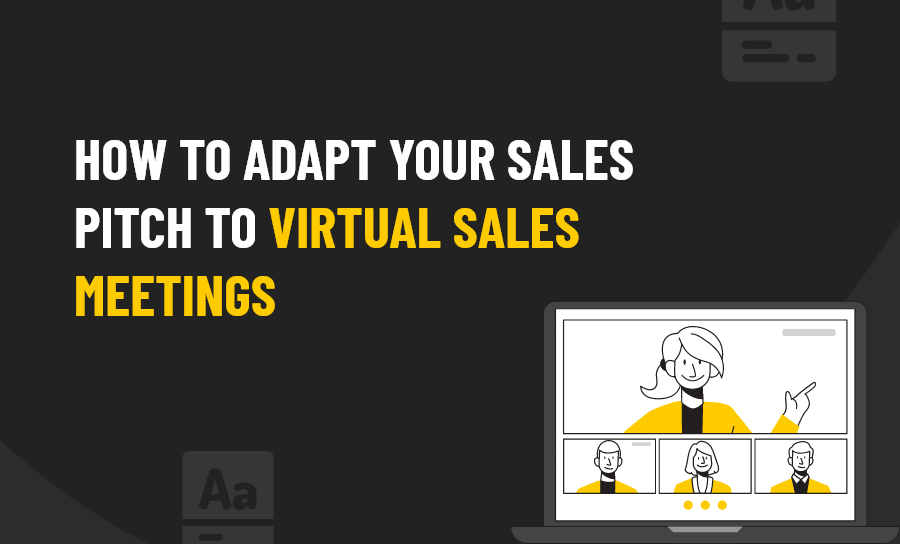Adapt Your Sales Pitch: Strategies
It’s the official start to 2023 but the world is far from back to normal in the face of the COVID-19 pandemic and virtual sales calls are now becoming the norm, whether you like it or not.
During a virtual sales meeting, selling requires different skills, and more planning than a meeting in person. If you’re trying to sell over the phone or Zoom the same way you’ve been selling when you’ve been able to get in your car and meet your customers in person, it won’t go well for you. Remote selling is different from selling in person. It is tougher. It calls for more planning. You need to be better prepared. And that’s just for starters.
With all this in mind, here is a look at some of the most important dos and don’ts of remote selling.
DON’T TRY TO WING IT
BRING VIRTUAL GOODIES
PREPARE TO MEET SEVERAL TIMES TO GET SALEs

A misconception many veteran sales pros have is that a Zoom-based sales call will be a one-and-done virtual meeting – that the “hello,” the presentation, and the deal will all wrap up in a single call. Don’t count on that.
Firstly, people tend to expect virtual conferences and telephone calls to be much briefer than meetings held in person. They may have only planned an hour for the call, and your virtual doughnuts may have taken up 15 minutes. Their idea of how the call will go might be different from yours.
During an hour-long face-to-face meeting, before digging into the client’s dilemma, a sales pro may spend some time on small talk. The discussion might then shift to the services and products provided by the salesperson’s company and how they could benefit the consumer. Then, there’s often still question-and-answer time before the potential client brings a supervisor or colleague in. The aim of that first meeting is often not an on-the-spot sale; it is to get a second meeting on the books, at least.
Actual sales aren’t always fast, particularly for big-ticket items. Clients need time to consider, evaluate and even seek permission. They have to figure out if the money’s working. They are also not usually prepared at the first meeting to sign a contract. But salespeople willing to spend this extra time with consumers in-person prefer to plan to wrap things up with a client after their initial virtual call. It is harder to gauge the duration of the sales cycle when you can’t interact in person.
In an artificial ‘physical’ environment like Zoom, you need to prepare for every part of the meeting and be ready to move at the client’s pace. If your prospect needs to get approvals from a slew of middle managers, think about sending virtual doughnuts to all of them – and to spend a bit of online time with them too. Don’t go for the jugular – and scare off your prospect – by making your pitch or asking for the sale too soon.
BE FRIENDLY, BUT STAY FORMAL AND PROFESSIONAL
The friendliest sales pros usually seem to close the most sales. But virtual, online meetings can rob their sales pitch of personality. There’s a formality online that doesn’t exist in person. This means it is even more important to have a plan for each virtual interaction than it is for face-to-face meetings.
First, present yourself in a businesslike manner. Months into the COVID-19 pandemic everyone seems to be getting a little too comfortable working at home – growing straggly beards, throwing their hair up into a ponytail, relaxing on the couch, and dressing in T-shirts and sweats.
That’s no way to look during a business meeting. Lock your kids, roommates, and pets out of the room where you will be talking to your clients. Never, ever make the call while sitting or reclining on a bed. In fact, your bed should not be visible on the screen, because that’s just weird.
Head into the virtual meeting with clear goals. Will you get to know the client and talk about your products and services? Will you ask for a second meeting or ask for the sale during the first one? Jot down a list of questions to ask the client during the meeting so you will gather the information you need to determine if your product is a good fit. Pay attention to not only the client’s answers but also their body language, tone of voice, attitude, pauses, and eye contact – all observations that a sales pro would instinctively make during an in-person meeting.
LEARN HOW TO WORK WITH WHAT YOU’VE GOT
This new normal stuff is STILL taking time to get used to, but the disruptions are going to continue, all over the world, for months yet. The hopes some had in March that things would be ‘back to normal’ by Christmas are fading fast. So, everyone must get a lot better at working with what they’ve got, and that includes sales professionals.
Experiment with alternatives. Try Zoom, Facetime, Google Meetings or another video conferencing platform for your next sales meeting. If you’re selling to young buyers who prefer texting or Whatsapping, give that a shot – although much is lost during a meeting with no video.
For those who want to talk by phone and skip the video, do your best to convince them that you don’t care if they haven’t washed their hair for weeks, so they’ll agree to turn on the camera, just so you can get that extra insight that can only come from eye contact (although don’t tell them that.) However, in the end even a text or telephone meeting is better than no meeting at all. Let your client pick the platform and adjust your pitch to it.
The fact is that it’s easy to meet online, and some people are finding they really like virtual meetings. When the health crisis is over, you may find that without personal visits you and your customers will get more work done – as long as you are able to build a new way of doing business that does not require in person interactions with people.
And speaking of that, as a team the Pearl Lemon Leads sales crew have always worked virtually. So when you work with, or consult, with us you will not only boost your lead gen efforts so you can book more of these virtual sales calls but also benefit from our years of experience when it comes to the art of making genuine connections without in person meetings.
Ready to discuss your lead generation needs? Or just to ask questions about how to adjust to a virtual sales environment? We’re happy to help, so book a call here, and we’ll get started (and no, we don’t care if you haven’t shaved or washed your hair in weeks.
FAQs
Virtual sales calls are quite the challenge because the sales representative has to be skilled in active listening. If you are having a virtual sales meeting where you can see their face it is easier to act based on their expressions. On the phone, a sales pitch needs to be adjusted based on the tone of the client’s voice and responses. Keep the call casual and show that the client is being heard and that the sales team is there to help.
A virtual sales pitch can be quite difficult as it can feel less personal. Online sales meetings should be able to be clear about who they are and explain the problem the client is having. Once there is a clear understanding of the problem the sales representative needs to provide how their product will solve the problem.





